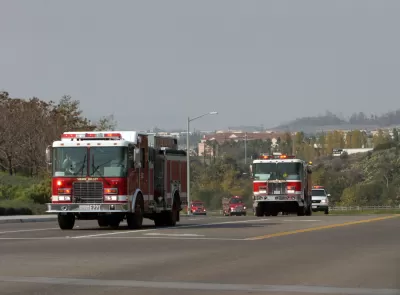The ear-piercing sirens used by emergency vehicles are shown to have little impact on patient outcomes while contributing to more dangerous road conditions, experts say.

Some experts are questioning the effectiveness of sirens and lights for emergency vehicles, noting that "[s]tudies have found that the time saved responding to medical calls by relying on lights, sirens and speed is not meaningful in most cases." As Christopher Mele reports, the overuse of sirens "can be a force multiplier for more harm than good."
Research has found that "[e]mergency drivers are more likely to engage in risky behavior when they use lights and sirens," while "other drivers sometimes respond in unpredictable ways," creating dangerous conditions that can lead to crashes. In fact, "an average of 4,500 such accidents occurred annually from 1992 to 2011, resulting in an average of 33 deaths and injuries to 2,600 people each year."
As far as their effectiveness at reaching patients, "the use of lights and sirens has been shown to have little bearing on patient outcomes," saving "an average of 42 seconds to three minutes off a trip to the scene of a call. According to Dr. Douglas F. Kupas, E.M.S. medical director for Geisinger E.M.S. in central Pennsylvania, "[m]ost of the things that are time-dependent are a very tiny minority of the E.M.S. calls." With consistent exposure to sirens, EMS workers "can suffer premature hearing loss," while patients "can be stressed by the noise."
FULL STORY: Sirens: Loud, Ineffective and Risky, Experts Say

Alabama: Trump Terminates Settlements for Black Communities Harmed By Raw Sewage
Trump deemed the landmark civil rights agreement “illegal DEI and environmental justice policy.”

Study: Maui’s Plan to Convert Vacation Rentals to Long-Term Housing Could Cause Nearly $1 Billion Economic Loss
The plan would reduce visitor accommodation by 25% resulting in 1,900 jobs lost.

Planetizen Federal Action Tracker
A weekly monitor of how Trump’s orders and actions are impacting planners and planning in America.

Wind Energy on the Rise Despite Federal Policy Reversal
The Trump administration is revoking federal support for renewable energy, but demand for new projects continues unabated.

Passengers Flock to Caltrain After Electrification
The new electric trains are running faster and more reliably, leading to strong ridership growth on the Bay Area rail system.

Texas Churches Rally Behind ‘Yes in God’s Back Yard’ Legislation
Religious leaders want the state to reduce zoning regulations to streamline leasing church-owned land to housing developers.
Urban Design for Planners 1: Software Tools
This six-course series explores essential urban design concepts using open source software and equips planners with the tools they need to participate fully in the urban design process.
Planning for Universal Design
Learn the tools for implementing Universal Design in planning regulations.
Caltrans
Smith Gee Studio
Institute for Housing and Urban Development Studies (IHS)
City of Grandview
Harvard GSD Executive Education
Toledo-Lucas County Plan Commissions
Salt Lake City
NYU Wagner Graduate School of Public Service





























